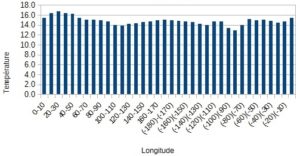by Carl-Stéphane Huot, 30 juillet 2019 in ScienceClimatEnergie
La notion de réchauffement climatique préoccupe bon nombre de gens depuis des années. Cependant, ce réchauffement apparent pourrait être influencé par le déplacement de stations météorologiques vers les zones plus chaudes de la planète, soit plus près de l’équateur, soit à des altitudes plus basses. La modélisation du climat est aussi influencée par l’existence de régions sans, ou avec très peu, de stations météorologiques.
…

Graphique 1 : Température moyenne selon la classe de longitude.
…
Conclusion
La variation extrêmement élevée du nombre de stations météorologiques servant au calcul de la température mondiale a contribué depuis le début des années 1950 à une partie au moins de l’élévation de température. La dérive de celles-ci d’une place à l’autre fausse la précision des données que l’on peut en tirer, et contribue à augmenter l’inquiétude de la population. L’emplacement et le nombre de stations à installer posent un certain nombre de problèmes autant scientifiques que techniques et politiques, et rend, avec d’autres éléments, (par exemple l’effet d’urbanisation, non abordé ici) extrêmement difficile de parler de réchauffement climatique.
